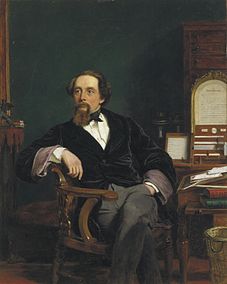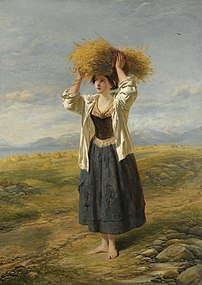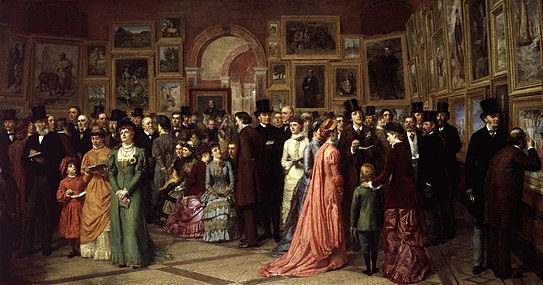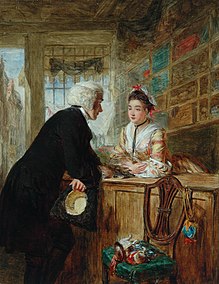William Powell Frith
William Powell Frith | |
|---|---|
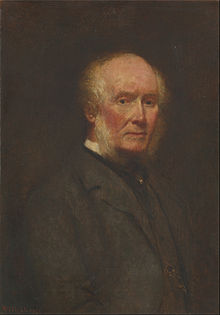 Self-Portrait at the Age of 82 (1901) | |
| Born | 9 January 1819 Aldfield, England |
| Died | 2 November 1909 (aged 90) London, England |
| Known for | Painting |

William Powell Frith
Early life
William Powell Frith was born in Aldfield, near Ripon in the then West Riding of Yorkshire on 9 January 1819. He had originally intended to be an auctioneer.[5] His mother was Jane Frith, née Powell (1779–1851). Frith was encouraged to take up art by his father, a hotelier in Harrogate. Frith was great uncle and an advisor to the English school portrait painter Henry Keyworth Raine (1872–1932).[6]
He moved to
Career
He was a member of

His 1858 painting The Crossing Sweeper has been described as breaking "new ground in its description of the collision of wealth and poverty on a London street."[10]
Later in his career he painted two series of five pictures each, telling moral stories in the manner of William Hogarth. These were the Road to Ruin (1878), about the dangers of gambling, and the Race for Wealth (1880) about reckless financial speculation. He retired from the Royal Academy in 1890 but continued to exhibit until 1902.
Frith was a traditionalist who made known his aversion to modern-art developments in a couple of autobiographies – My Autobiography and Reminiscences (1887) and Further Reminiscences (1888) – and other writings. He was also an inveterate enemy of the
In his later years, he painted many copies of his famous paintings, as well as more sexually uninhibited works, such as the nude After the Bath. A well-known raconteur, his writings, most notably his chatty autobiography, were very popular.
In 1856, Frith was photographed at "The Photographed Institute" by
Frith died in 1909 aged 90 and is buried in Kensal Green Cemetery in London.
Exhibitions and legacy
The first major retrospective in Frith's native Britain for half a century was staged at the Guildhall Art Gallery, London in November 2006. It transferred to Mercer Art Gallery in Harrogate, North Yorkshire, in March 2007. Frith's study for his last major work, The Private View, 1881, is in the Mercer Art Gallery. His work was also shown at the Whitechapel Gallery in London during an exhibition running from 25 October – 1 December 1951.[12] Frith has paintings in the collection of several British institutions including Derby Art Gallery, Sheffield, Harrogate and the Victoria and Albert Museum.[13]
Personal life
Frith was married twice. He had twelve children with his first wife, Isabelle, whilst a mile down the road maintaining a mistress (Mary Alford, formerly his ward) and seven more children – all a marked contrast to the upright family scenes depicted in paintings like Many Happy Returns of the Day.[14] Frith married Alford a year after the death of Isabelle in 1880.[15] A daughter from his first family, Jane Ellen Panton, published Leaves of a life in 1908. It is a book of childhood reminiscences describing her father and the family's set of artist and literary friendships, chiefly members of The Clique. Walter Frith, the third son from Frith's first marriage, was the author of fourteen plays and three novels.
Gallery
-
The Crossing Sweeper, 1858
-
The Two Central Figures in "Derby Day", at the Metropolitan Museum of Art, 1860
-
The Little Gleaner, circa 1850
-
Aesthetic movement. Wilde is the main figure at the right, standing in front of the boy wearing green.
-
Dolly Varden, 1842. Dolly Varden is a character from Barnaby Rudge by Charles Dickens.
-
An English Merrymaking a Hundred Years Ago, 1847
-
At My Window, Boulogne
-
The Beautiful Grisette, 1853. A scene from Laurence Sterne's A Sentimental Journey Through France and Italy
-
Ramsgate Sands, 1854
-
Olivia unveiling, 1874. From Act I, Scene 5 of William Shakespeare's Twelfth Night
-
Claude Duval, 1860
-
Paddington railway station.
-
The Marriage of the Prince of Wales, 1865. Depiction of the Wedding of Prince Albert Edward and Princess Alexandra
Writings
- My Autobiography and Reminiscences (1887).ISBN 1-116-49774-3)
- Further Reminiscences (1888).
- John Leech, His Life and Work, 2 vols. (1891).
References and sources
- Citations
- ^ "FRITH, William Powell". Who's Who. Vol. 59. 1907. p. 643.
- ^ "Royal Academy of Arts Collections".
- ^ Wilman, George (1882), "William Powell Frith, R.A.", Sketches of living celebrities, London: Griffith and Farran, pp. 129–134
- ^ William Powell Frith: Painting the Victorian Age. Harrogate Borough Council, 2011. Retrieved 19 April 2013. Archived 18 July 2015 at the Wayback Machine
- TheGuardian.com. 10 June 2011.
- ^ "The Minneapolis journal. (Minneapolis, Minn.) 1888-1939, May 13, 1906, Part II, Editorial Section, Image 20". 13 May 1906. p. 8 – via chroniclingamerica.loc.gov.
- ^ "Charles Dickens | Frith, William Powell (RA) | V&A Explore the Collections".
- TheGuardian.com. 10 June 2011.
- ^ "In the collection of Royal Holloway, London University". Retrieved 24 October 2014.
- ^ Bills, Mark. "William Powell Frith's 'The Crossing Sweeper': An Archetypal Image of Mid-Nineteenth Century London (2004-05)". The Burlington Magazine. p. 300.
- ^ "Robert Howlett". Oxford Dictionary of Biography. Oxford University Press. Retrieved 22 August 2012.
- ^ Whitechapel Gallery
- ^ William Powell Frith, BBC, accessed August 2011
- ^ "Many Happy Returns of the Day by William Powell Frith".
- ^ Wainwright, Martin (26 March 2007). "Where's Mary? Hunt is on for Victorian artist's secret mistress". Guardian. London. Retrieved 26 March 2007.
- ^ "Review of My Autobiography and Reminiscences by W. P. Frith". The Saturday Review of Politics, Literature, Science, and Art. 64 (1671): 631–632. 5 November 1887.
- Sources
- Chisholm, Hugh, ed. (1911). . Encyclopædia Britannica (11th ed.). Cambridge University Press.
Further reading
- Bills, Mark (2006). William Powell Frith: Painting the Victorian Age. Yale University Press. ISBN 0-300-12190-3
- Wood, Christopher (2006). William Powell Frith: A Painter and His World. Sutton Publishing Ltd. ISBN 0-7509-3845-5
External links
- Works by William Powell Frith at Project Gutenberg
- Works by or about William Powell Frith at Internet Archive
- William Powell Frith at Artcyclopedia (images from various Museums and image galleries)
- Phryne's list of pictures by Frith in accessible collections in the UK at the Wayback Machine (archived May 12, 2008)
- William Powell Frith page at the Mercer Art Gallery, Harrogate.
- William Powell Frith chronology at the Mercer Art Gallery, Harrogate. Archived here.
- Profile on Royal Academy of Arts Collections
- 95 artworks by or after William Powell Frith at the Art UK site
- La Sacristía del Caminante: ‘Sherry, Sir?’ de William Powell Frith y las Bodegas Williams & Humbert.

